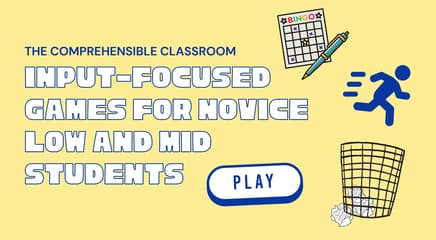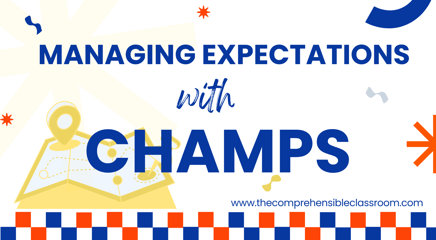Some of you may know that I have the mother of all multi-level classes this year: 6th-12th grade, 1st-7th year Spanish. I asked parents and students for grace during the first few weeks as I figured out how to meet everyone's needs, and they did. We are now finishing up week four, and I have a plan--at least, a short-term plan.
We know that we learn a new language by reading or hearing language that is slightly beyond our current proficiency level. My upper-level students could certainly pick up new things from participating in my first-year Spanish activities (storytelling, PQA, readings, etc.), but really it is difficult to challenge my student that has just come out of immersion without intimidating my lower-level students. Not impossible--I know that there are teachers out there that do it--but not easy. But I don't have the time to spend hours outside of class planning for four different levels of students!
So I created a packet for them to work on independently. Oh, the horrors! I am the worst!
Actually, I am kind of excited about it. You see, it's not-your-average packet: it is one that goes hand-in-hand with reading a novel--or any text, for that matter. We know that students improve proficiency through Comprehensible Input, and this packet is designed to give them additional repetitions of the CI that they receive from another source (ex: a novel). The six students that will have the option to work on it are (1) very good at Spanish--some coming from six years of immersion and others from as many as four years of traditional Spanish classes, (2) very bright students, and (3) studious--you know, the kind that like just doing things on their own, at their own pace. So that's what they are getting--I'm calling it "Independent Textivities". See below for details:

Step 1: Kids read the description of Independent Textivities, sign it, and take it home for their parents to read and sign. If they don't want to do it, they are free to just continue on with us in class, and I will continue to do my best to challenge them at their level.
Step 2: Kids choose a novel to read. I have a great selection of novels that are written for language learners from TPRS Publishing! Three of the students, with lesser language experience, chose to start with Piratas, and the three more advanced students chose to begin with Llorona.
Step 3: On designated days, kids read the novel, chapter by chapter. Some days, they do not have the option to work independently, since I want them in the class so that they are a part of it and receive auditory comprehensible input from me. While reading each chapter, they keep a list of new-to-them vocabulary words (so that I can monitor what they know and make sure that the novel really is a good fit for them).
Step 4: After reading each chapter, they choose three activities from the Textivities selection page: one from each column, and each from a different row. When I give them the Textivities cover sheet, I also give them one copy of each form on the choice page so that they have everything they need to work independently.
- In the left-hand column, there are activities that students complete in English. This is so that I can know for certain that students understood the chapter. It is very possible to complete 'comprehension' activities in Spanish about a text without actually understanding the text at all. A good test taker is able to read "Bob come pizza" and answer the question "¿Quién come pizza?" without having any idea what 'come' means!
- In the center column, there are activities that require students to use higher-order thinking skills as they complete them in Spanish. This gives them additional repetitions of the structures, since they are encouraged to use the text ('open book') while completing them. Since it requires them to use higher-order thinking skills, it is intellectually stimulating for these bright students.
- In the right-hand column, there are activities that require students to create some kind of an activity that another student complete. Again, this gives them more repetitions of the structures and forces them to create with the language, but frankly I did this so that Ido not have to spend planning time creating activities for them. Since three students are reading each of the novels, I will have them exchange activities that they created for each chapter.
Step 4: Students hand in everything to me, I give them feedback and instruction where needed, photocopy the activities that they created and re-distribute, and they move on to the next chapter. They are not allowed to repeat any activity until they have done each activity once.
If you'd like to use the same activities that I do, you can purchase the full packet, with forms for all of the activities, here. The 18 forms are included in Spanish, French, and English, and they can be used for any reading that the whole class has done, for sub plans, or any other use that you dream up. However, if this independent plan sounds like something that might work for you, I would encourage you to write your own activity options based on things that your students are already familiar with and/or are initiatives in your school.





